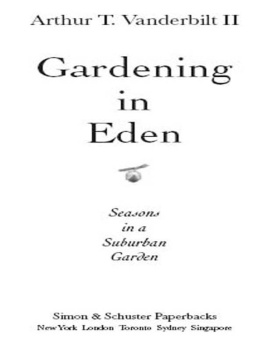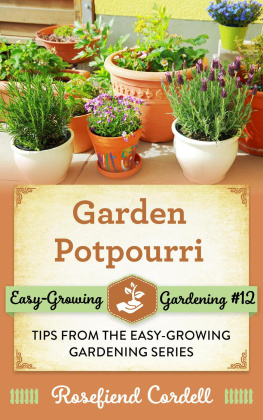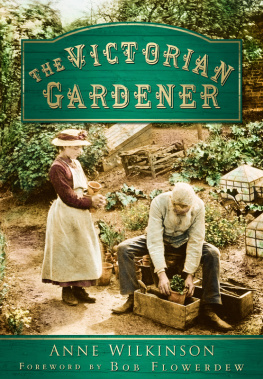
The editors would like to thank the following for their kind help: Julian Bingley, Anna Braioni, Gianna Braioni, Barrie Bullen, Roderick Conway Morris, Christine Donougher, Gregory Dowling, the Fondazione Benetton, Robert Hill, Franois Houtin, Nicola Kennedy, Francis Kyle, Dr. David Lambert of the Garden History Society, Donna Leon, William and lone Martin, Oxford University Botanical Gardens, Horti Praefectus, Katinka Pree, Vera Ryhajlo, Robert Stoney, Clova Stuart-Hamilton, and Roma Tearne, Timothy Walker, Charlotte Ward-Perkins.
They would like to express their particulat thanks to Pierre Higonnet of the Galleria del Leone, Venice, and to Galerie Michle Broutta, Paris, for introducing them to the works of Franois Houtin.
The editors would also like to thank Gwyn Headley for permission to quote from Follies, A Guide to Rogue Architecture in England, Scotland and Wales by Gwyn Headley & Wim Meulenkamp (Jonathan Cape, London 1986); and ditions Gallimard, Paris, for permission to reproduce Sept jardins fantastiques by Andr Pieyre de Mandiargues.
T ABLE OF C ONTENTS

In October 1995, we were approached by Dedalus and offered the chance to edit more of the writings of Durian Gray and Medlar Lucan. We were not only delighted by the offer, but also curious to know what Gray and Lucan had been up to since the closure of their infamous restaurant in January 94. After their sudden departure from Edinburgh, they had completely vanished. Of course, rumours of their whereabouts abounded - they had been spotted in Samarkand, in Fez, in Cartagena - each location mentioned more exotic than the last. So it came as something of a surprise when a confirmed sighting of the two fugitives was made on the south west coast of Ireland. It seemed a most unlikely destination for such inveterate urbanites and there was general concern as to whether their delicate health would survive exposure to all that clean air and the rigours of country living.
These fears were allayed by the news that Gray and Lucan were guests of Mrs Conchita Gordon at her country seat, Mountcullen. This splendid woman had been a regular and welcome guest at the Edinburgh restaurant. On one occasion, she hired a cabinet particulier to entertain a down-and-out who had stopped her in the street and asked for the price of a cup of tea. It was an act of generosity from which the poor man never recovered. Gray and Lucan were clearly in good hands and a stay at Mountcullen might allow them to rest and recuperate.
By what proved to be a happy coincidence, they arrived at a time when Mrs Gordon was thinking of redesigning the gardens which surrounded her house. Whether in a moment of madness or inspiration it is difficult to say, but she made up her mind that her two guests would be ideally suited to this task. A project like this would help them put their recent disappointments behind them, and After all, Mrs Gordon argued, if one can design a menu, one can design a garden.
Mountcullen, which had recently been acquired by Conchita Gordon, is a well-proportioned Georgian house in Co. Cork. It stands squarely in eighteen acres of gardens and woods. From the front of the house, one looks out across a broad expanse of parkland and mature trees towards the waters of Lough Doon in the distance. Offshore lies a small island which forms part of the estate. The back of the house is protected by a ring of thickly-wooded hills at the foot of which flows the river Cull. It describes a graceful curve through the grounds before debouching into the lake about a mile to the south-east of the house.
The climate in this part of the country is very mild - mild enough to support certain varieties of exotic plants - and the soil is rich and fertile, ideally suited to creating gardens. Immediately around the house were a series of formal gardens, orchards, walled kitchen gardens and greenhouses. Beyond these a sort of park had been laid out. All had been neglected for many years and one of the great attractions of the estate for Mrs Gordon was its air of romantic melancholy. Lucan and Grays ambitions for the grounds would soon change all that.
It took very little to persuade them to undertake the task of redesigning the gardens. Unencumbered by doubts or experience, they set about the project with their usual lan. Many hours were spent in the library at Mountcullen and in Dublin, immersing themselves in the history of garden design, poring over vast horticultural tomes, poking around in the rich compost of garden history. Conchita Gordon saw little of her guests during this period. They became secretive and obsessed, and began communicating with their patroness by pushing notes under the locked door of the library. After six months or so without tangible results, however, the gracious hostess was becoming impatient. She wanted a full progress report at once.
The two designers began by explaining their overall conception for the new gardens. According to Mrs Gordon, they had become intrigued by the figure of Bernard Palissy, a 16th century French ceramicist and staunch Protestant. Monsieur Palissy was a man at odds with his times. He saw himself living in a world ruled by folly. He played the role of a second John the Baptist, railing against decadence, greed and corruption. His aim was to use whatever weapons were at his disposal in the fight against depravity, and one project he considered was the building of a garden - a garden which would be entirely devoted to the celebration of wisdom.

Durian Gray and Medlar Lucan photographed in the Library at Mountcullen, posing as James Joyce and Augustus John.
Palissys Garden of Wisdom was to be made up of eight different areas. In each of these areas, the visitor would find tranquillity and repose. Edifying texts from Proverbs or Ecclesiastes would be carved into stone tablets or formed from cut branches. At the very heart of the garden a pavilion would stand, bearing the words of warning: Cursed be those who reject Wisdom. At the four corners of the garden would stand rustic cabinets. These would be constructed on a brick frame over which would be placed large pieces of rock uncut and unpolished so that the exterior of the said cabinet would in no way have the appearance of a building. Herbs and shrubs would be planted on top and water made to trickle down the outside as if springing from the rock itself. Inside the cabinet was a furnace in which would be smelted the enamels used to line the walls. Hence, like a shell, the cabinets would be rough on the outside and smooth and multi-coloured on the inside.
Unfortunately, only verbal descriptions of the garden are available. No exact plans exist. This was deliberate on Palissys part. Only the initiated few would be allowed access, so to speak, to his garden of Wisdom
Mrs Gordon was not at all sure what the connection was between this pious, Protestant craftsman and the former proprietors of The Decadent restaurant. So Lucan and Gray went on to explain that here was a clear case of the attraction of opposites. Their intention was to take Palissys idea of the Garden of Wisdom and turn it on its head. Their Grand Design was to remodel the estate at Mountcullen as a celebration of Decadence and Folly. Where Monsieur Palissy had engaged in an intimate and respectful dialogue with Nature, they would be roundly abusing her. They saw her as the enemy. The goddess had to be vanquished, enslaved, placed in bondage. The Artificial is what they venerated. Whereas Palissys style would countenance no antique statues, grotesque sculptures, low reliefs of satirical or pastoral subjects from pagan fables, Gray and Lucans style consisted of little else. Palissy laid great stress on reason and order in his garden. In their designs, Gray and Lucan sought to represent the excessive and the irrational. The land-lady whole-heartedly approved of the conception thus far, but she wanted a little more flesh on the bones.
Next page













